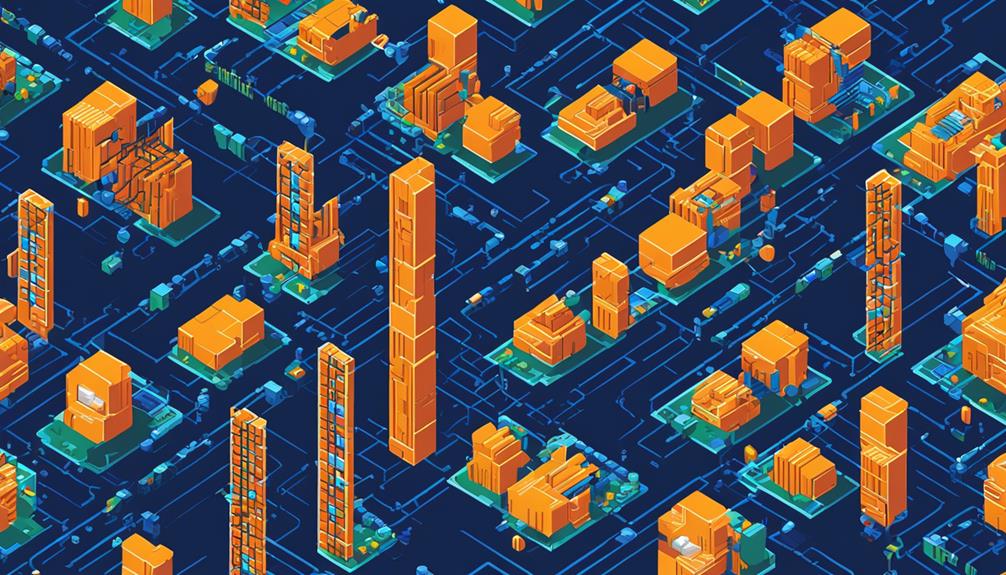As the world transitions into the era of 5G, the significance of network infrastructure hardware cannot be overstated. This hardware serves as the backbone for the seamless functioning of 5G technology, enabling faster data transfer, increased network capacity, and improved coverage.
Key components such as massive MIMO technology, base stations, integrated radio units, and power amplifiers play a crucial role in optimizing the performance of 5G networks. With leading manufacturers like Qualcomm, Huawei, and Samsung pushing the boundaries of innovation, the development of advanced 5G hardware components is well underway.
However, the story doesn't end there. Ongoing research and development efforts are focused on further enhancing the efficiency of these components, reducing power consumption, and unlocking the full potential of the 5G spectrum.
The future holds exciting possibilities in the field of 5G hardware, and the advancements in this area are critical for achieving widespread 5G connectivity and enabling future advancements in mobile networks.
Key Takeaways
- Massive MIMO technology improves network capacity using beamforming techniques.
- Upgrading network infrastructure hardware enables faster data rates and increased network capacity.
- Small cell networks augment macro cell towers, increasing network capacity and coverage.
- Advancements in hardware components are critical for achieving widespread 5G connectivity.
Key Components of 5G Hardware

The key components of 5G hardware play a crucial role in enhancing network capacity, coverage, and performance. One of the key technologies that contribute to these improvements is Massive MIMO (Multiple Input Multiple Output). Massive MIMO utilizes a large number of antennas at both the transmitter and receiver ends to increase the data rate of a 5G network. By using beamforming techniques, Massive MIMO improves network capacity by enabling multiple users to simultaneously transmit and receive data on the same frequency band.
Upgrading hardware components is essential to support the transition to 5G. 5G chipsets, for example, are designed to support both 5G and 4G signals, ensuring seamless connectivity for users. These chipsets are integrated into devices such as smartphones, tablets, and IoT devices, allowing them to connect to the 5G network.
Another important component of 5G hardware is small cell networks. Unlike traditional cell towers, small cells are low-powered and can be deployed in dense urban areas to enhance coverage and capacity. These small cells are connected to the network infrastructure and provide a more localized coverage, improving the overall network performance.
Integrated radio units are also crucial for 5G networks. These units support different frequency bands and are particularly important for improving millimeter wave coverage. Millimeter waves have higher frequencies and shorter wavelengths, enabling faster data transmission. However, they have limited range and are easily blocked by obstacles. Integrated radio units help overcome these challenges by allowing for better propagation and coverage.
Leading manufacturers in the development of 5G hardware components include Qualcomm, Huawei, and Samsung. These companies invest heavily in research and development to create innovative and efficient hardware solutions for mobile operators and telecom equipment providers.
Upgrading Hardware for 5G Deployment
With the foundation of key components in place, the next step in the advancement of 5G networks involves upgrading the hardware for seamless deployment. Upgrading network infrastructure hardware is crucial to meet the demands of 5G deployment, as it enables faster data rates, increased network capacity, and improved overall performance. Leading manufacturers such as Qualcomm, Huawei, and Samsung are at the forefront of 5G hardware development, continuously improving network capacity while reducing power consumption.
One significant hardware upgrade for 5G deployment is the integration of massive MIMO technology. Massive MIMO (Multiple-Input Multiple-Output) systems utilize multiple antennas to transmit and receive data simultaneously. This technology significantly increases data rates and network capacity, allowing for faster and more efficient communication.
Another hardware upgrade for 5G deployment involves repurposing existing network equipment. 5G networks can utilize some of the existing 4G LTE sites for low-band and mid-band frequencies. Additionally, small cell networks can be deployed to augment macro cell towers, increasing network capacity and coverage.
The advancement of hardware components also includes the development of integrated radio units. Integrated radio units combine antennas, radios, and digital units into a single module, making it easier to install millimeter wave coverage. This advancement makes millimeter wave technology more accessible for large-scale applications.
Furthermore, software-defined networking (SDN) plays a crucial role in upgrading network infrastructure hardware for 5G deployment. SDN allows for centralized management and control of network resources, making it easier to deploy, scale, and manage 5G networks effectively.
Top Manufacturers for 5G Network Infrastructure

Qualcomm, Huawei, and Samsung lead the market for 5G network infrastructure hardware, showcasing their expertise through groundbreaking advancements and innovative solutions. These companies are at the forefront of the 5G revolution, providing cutting-edge equipment to support the deployment of 5G networks.
Qualcomm has developed a 5G modem that supports speeds up to 10 Gbps, enabling faster and more reliable mobile network connections. This technology empowers service providers to deliver high-quality and low-latency services to their customers. Additionally, Qualcomm's expertise in wireless technology allows for seamless integration of 5G capabilities into mobile devices.
Huawei, on the other hand, has launched a new generation of 5G massive MIMO with lower power consumption and increased bandwidth. This technology improves network efficiency and capacity, enabling service providers to deliver enhanced mobile experiences. With Huawei's solutions, service providers can optimize their network performance and meet the growing demands of their customers.
Samsung, in collaboration with Intel, has achieved speeds of 305 Gbps on a 5G User Plane Function (UPF) Core. This breakthrough in Edge computing and small cell technology demonstrates Samsung's commitment to pushing the boundaries of 5G network infrastructure. The high speeds achieved by Samsung and Intel highlight the potential of 5G networks to support advanced applications and services.
While Qualcomm, Huawei, and Samsung are leading the way in 5G network infrastructure hardware, it's important to note that many other companies are also making advancements in this field. As the demand for 5G networks continues to grow, manufacturers are investing heavily in research and development to provide the best equipment and solutions for service providers. The competition among manufacturers is driving innovation and ultimately benefiting consumers with faster, more reliable, and more efficient 5G networks.
Future Trends in 5G Hardware Development
Future trends in 5G hardware development focus on the implementation of massive MIMO technology to enhance network capacity and expand coverage. This technology enables multiple antennas to be used for transmitting and receiving signals simultaneously, resulting in increased data rates and improved network performance. Here are four key trends in 5G hardware development:
- Rethinking traditional network architecture: 5G hardware development involves reimagining the way networks are built and operated. It aims to create a new network that is more flexible, scalable, and efficient, capable of supporting diverse applications and services.
- Enhanced mobile broadband: 5G hardware development aims to deliver significantly faster speeds and higher capacity to meet the increasing demand for data-intensive applications. This will enable users to stream high-definition videos, download large files, and enjoy immersive virtual reality experiences seamlessly.
- Low latency: 5G hardware development focuses on reducing latency, which is the delay between sending and receiving data. This is crucial for real-time applications such as autonomous vehicles, remote surgery, and virtual reality gaming, where even a slight delay can have significant consequences.
- Internet of Things (IoT) integration: 5G hardware development aims to provide seamless connectivity for the billions of IoT devices expected to be deployed in the coming years. This requires developing hardware components that can efficiently handle the massive scale and diverse requirements of IoT applications.
To achieve these goals, advancements in 5G hardware components are being made. This includes integrating radio units for easier installation of millimeter wave coverage, developing efficient power amplifiers to meet 5G performance requirements, and creating system-on-a-chip solutions for energy-efficient, application-specific integrated circuits.
Additionally, manufacturers are repurposing 4G LTE sites and devices to support both 4G and 5G networks, maximizing the use of existing infrastructure. These developments are crucial for the successful deployment and operation of 5G networks, enabling the realization of the full potential of this transformative technology.
Mobilizing 5G Networking Gear

The process of mobilizing 5G networking gear involves the deployment and optimization of 5G cellular networks, accompanied by advancements in mobile broadband, to enable the widespread implementation of this transformative technology in 2021. To understand the significance of mobilizing 5G networking gear, let's take a closer look at the key components and their functionalities.
| Key Components | Functionalities |
|---|---|
| Millimeter Wave | Utilizes high-frequency bands to transmit data at high speeds |
| Signals Reach | Extends the coverage area and ensures reliable connectivity |
| Network Resources | Efficiently allocates network resources to connected devices |
| Frequency Band | Determines the capacity and speed of the network |
| Connected Devices | Enables seamless communication between devices and networks |
| Wireless Networks | Provides wireless connectivity to mobile phones and devices |
Mobilizing 5G networking gear involves harnessing the potential of millimeter wave technology. This higher frequency band allows for faster data transmission. By utilizing millimeter waves, 5G networks can provide significantly higher speeds and lower latency compared to previous generations.
In addition to speed, mobilizing 5G networking gear focuses on expanding the reach of signals. With improved antennas and beamforming techniques, 5G networks can extend their coverage area and ensure reliable connectivity, even in dense urban environments.
Efficiently allocating network resources is another crucial aspect of mobilizing 5G networking gear. With the growing number of connected devices, 5G networks need to intelligently manage network resources to ensure optimal performance and user experience.
Lastly, mobilizing 5G networking gear aims to enable seamless communication between wireless networks and a wide range of connected devices, including mobile phones, IoT devices, and autonomous vehicles. This connectivity will pave the way for advanced applications and services, revolutionizing industries such as healthcare, transportation, and manufacturing.
Frequently Asked Questions
What Is Network Infrastructure Hardware?
Network infrastructure hardware refers to the physical components and devices that form the foundation of a network. It includes routers, switches, servers, and other equipment that enable data transmission and communication.
Network infrastructure is crucial for organizations as it provides the framework for connectivity, data transfer, and collaboration. It encompasses scalability to accommodate growing demands, security measures to protect sensitive information, efficient management to ensure smooth operation, and adherence to best practices.
Future trends in network infrastructure technology focus on enhancing performance, increasing capacity, and adopting advanced security measures.
What Are Network Infrastructure Devices?
Network infrastructure devices are essential components that enable communication and interaction within computer networks. They include routers, switches, hubs, modems, and network interface cards (NICs).
These devices play a crucial role in data communication by facilitating the flow of information between network units. The design of network infrastructure is critical for optimal performance and is based on the open systems interconnection (OSI) model.
Challenges in designing network infrastructure include scalability and future proofing, as well as the impact on network performance.
What Hardware Is Required for 5g?
To deploy a 5G network, certain hardware components are essential. These include:
- Massive MIMO technology for increased data rates and coverage.
- Hardware upgrades for 5G smartphones.
- The integration of macro cell towers with small cell networks.
- The use of integrated radio units to facilitate the installation of millimeter wave coverage, which is crucial for achieving higher data rates and network capacity in 5G networks.
Top manufacturers in the 5G hardware market, such as Qualcomm, Huawei, and Samsung, are continuously developing and optimizing these components to improve network capacity and reduce power consumption.
What Infrastructure Is Needed for 5g?
To meet the requirements of a 5G network, several infrastructure components are necessary. These include advanced antennas, integrated radio units, and baseband units.
Challenges in 5G infrastructure include the need for denser networks, increased power consumption, and the deployment of small cells.
Key players in 5G infrastructure development include major technology companies like Qualcomm, Huawei, and Samsung.
The future of 5G infrastructure holds promises of faster speeds, low latency, and improved network capacity, which will have a significant impact on industries such as healthcare, transportation, and manufacturing.

